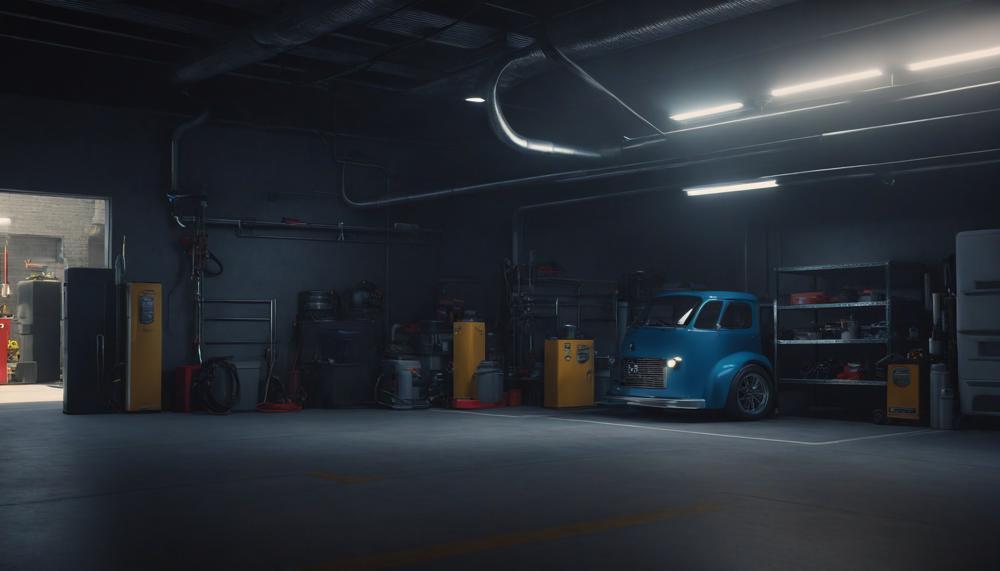Thinking of turning your garage into a smoking haven? Proper ventilation is crucial for maintaining air quality and ensuring your comfort. Whether you’re a cigar enthusiast or a casual smoker, the key to a pleasant experience lies in how well you can manage smoke and odors.
Without the right ventilation, your garage could become a stuffy, unpleasant space, affecting not just your smoking experience but also the overall air quality of your home.

Proper ventilation doesn’t have to be complex or costly. By understanding the available options and taking some practical steps, you can transform your garage into a well-ventilated space perfect for smoking. Here are the key takeaways to get you started:
- Inspect Your Garage: Look for signs of poor ventilation, like stuffy air or persistent odors.
- Evaluate Ventilation Options: Consider adding windows, exhaust fans, or air purifiers, each offering unique benefits.
- Implement Effective Solutions: Choose the best fit for your garage’s layout and your needs, whether it’s installing new ventilation systems or enhancing existing ones.
- Promote Airflow: Ensure continuous air circulation to prevent smoke buildup and maintain a comfortable environment.
Taking these steps will help you create a healthier, more enjoyable space for smoking, keeping your garage fresh and your home’s air quality intact.
Contents
Wall vents
Wall vents are small openings or passages installed in garage walls to facilitate air exchange, ensuring fresh air enters while stale air, including smoke, exits. They’re pivotal for maintaining air quality when smoking in a garage, preventing the buildup of harmful fumes.
How Wall Vents Work for Garage Ventilation
Key Features of Wall Vents:
- Airflow Control: They can be manually adjusted to regulate air flow.
- Cost-effective: Inexpensive and straightforward to install.
- Enhanced Ventilation: Work effectively even in garages without windows.
Proper Use of Wall Vents in a Garage for Smoking
Strategic Placement:
- Near Smoking Area: Position vents close to where smoking occurs to directly expel smoke.
- Cross-ventilation: Place vents on opposite sides of the garage to create a continuous flow of fresh air.
Maintenance Tips:
- Regular Cleaning: Clean vents annually to remove dirt and debris that could block airflow.
- Inspection: Regularly check for clogs and ensure vents are fully operational.
Advantages of Using Wall Vents
| Benefit | Description |
| Improved Air Quality | Ensures removal of smoke and pollutants, creating a healthier environment. |
| Cost-Effective Solution | Affordable and easy to install compared to other ventilation systems. |
| Simple Maintenance | Requires minimal upkeep to remain effective. |
Garage door vents
The best types of garage door vents for properly ventilating a garage for smoking are louvered vents, soffit vents, ridge vents, and gable vents.
These vents are designed to facilitate airflow, preventing smoke buildup and maintaining a healthier environment.
| Vent Type | Description | Advantages |
| Louvered Vents | Comprise multiple slats that can be opened and closed to control airflow. Typically made of aluminum or PVC. | Adjustable airflow control, durable, keeps debris and pests out. |
| Soffit Vents | Installed on the underside of the roof overhang, allowing air to flow in from outside and out through the top. | Continuous airflow, prevents smoke from lingering, made of aluminum or plastic. |
| Ridge Vents | Placed along the peak of the roof, allowing hot air to escape from the top while cool air is drawn in from the bottom. | Promotes natural convection, effective ventilation, suitable for various roof types. |
| Gable Vents | Installed on the gable ends of the garage, allowing air to flow in and out through the sides. | Aesthetic appeal, available in various shapes and sizes, made of aluminum, wood, or PVC. |
Exhaust fans
When it comes to ventilating a garage for smoking, several types of exhaust fans can be effective. Each type offers unique advantages, tailored to different garage layouts and ventilation needs.
| Type | Description | Ideal For |
| Wall-Mounted Exhaust Fans | Mounted on walls, expels air outside | Garages with sufficient wall space |
| Ceiling-Mounted Exhaust Fans | Installed on ceilings, draws air up | Small garages |
| Inline Exhaust Fans | Integrated within ductwork, discreet | Large or commercial garages |
| Attic Exhaust Fans | Positioned in attics, expels hot air | Garages attached to houses |
| Solar-Powered Exhaust Fans | Powered by solar panels, eco-friendly | Garages with good sunlight |
Selecting the right exhaust fan depends on your garage’s size, layout, and specific ventilation needs.
Air conditioning
Air conditioning systems can effectively ventilate a garage for smoking by combining cooling with proper air exchange. Here’s how to do it:
| Method | Details | Benefits |
| Air Conditioning with Ventilation | Use units that offer ventilation modes | Removes smoke, cools air, reduces odors |
| Exhaust Fans | Install near smoking areas | Enhances air exchange, prevents smoke buildup |
| Proper Airflow | Keep doors/windows open | Supports fresh air circulation |
| Air Purifiers | Use HEPA filters | Captures smoke particles, improves air quality |
| Maintenance | Clean/replace filters regularly | Ensures efficiency, prolongs system life |
For further information on ventilation and air conditioning systems, check out this detailed guide on air conditioning units.
Windows
Effectively ventilating your garage for smoking using windows requires strategic positioning and usage. Follow these steps for optimal results:
- Open All Windows: Start by fully opening all available windows in the garage. This creates cross-ventilation, allowing fresh air to enter while pushing smoke and stale air out.
- Position Box Fans: Place box fans in the windows. Set them to face outward to expel smoke from the garage. Positioning fans in this manner creates a suction effect that draws smoke towards the windows and out of the garage.
- Create Cross-Ventilation: If possible, open a door or another window on the opposite side of the garage. This encourages airflow across the space, enhancing the removal of smoke.
- Use Window Screens: Install window screens to keep bugs and debris out while allowing maximum airflow.
- Monitor Air Quality: Utilize a carbon monoxide detector and air quality monitor to ensure the garage remains safe and well-ventilated during smoking sessions.
Is it necessary to ventilate a garage?
Yes, it is necessary to ventilate a garage, especially for smoking. Proper ventilation is crucial in a garage to ensure safety and comfort. When smoking, without proper ventilation, harmful substances like carbon monoxide, tar, and nicotine can accumulate, posing serious health risks.
Why Proper Ventilation Is Important in a Garage, Especially for Smoking
Health Safety
- Prevents Carbon Monoxide Buildup: Smoking in an enclosed space like a garage can lead to dangerous levels of carbon monoxide, a colourless, odourless gas that can cause severe health issues, including headaches, dizziness, and even death. Ventilation disperses this gas, making the environment safer.
- Reduces Exposure to Secondhand Smoke: Proper ventilation helps minimise secondhand smoke exposure, which contains harmful chemicals that can affect non-smokers in the vicinity.
Improved Air Quality
- Eliminates Toxic Fumes: Cigarette smoke releases numerous toxic fumes, including tar and nicotine. Adequate ventilation systems expel these contaminants, ensuring the air remains cleaner and healthier to breathe.
- Reduces Odour: Smoking produces a strong odour that can linger and permeate surfaces in the garage. Ventilation helps to disperse the smell, maintaining a fresher environment.
Fire Safety
- Reduces Fire Hazard: Cigarette butts and ash can be potential fire hazards in a garage filled with flammable materials like paint, oil, and gasoline. Ventilation can help manage and control any unexpected ignition sources by circulating air and reducing concentration of flammable fumes.
Types of Ventilation Systems for Garages
| Type | Advantages | Drawbacks |
| Natural Ventilation | Simple, low-cost, effective in mild climates | Depends on weather, limited control |
| Mechanical Ventilation | Consistent air flow, effective in any climate | Higher cost, requires electricity |
| Hybrid Ventilation | Combines benefits of natural and mechanical systems | Complex installation, higher maintenance |
Tips for Effective Garage Ventilation:
- Install Exhaust Fans: Helps expel smoke and fumes directly outside.
- Use Window Fans: Position them to create a cross-breeze, drawing fresh air in and pushing smoke out.
- Keep Doors and Windows Open: Simple yet effective method to allow fresh air circulation.
- Air Quality Monitors: Use these to continuously check and ensure air remains safe.
Active or passive ventilation: Which is better
Active ventilation is generally more effective than passive ventilation for ventilating a garage for smoking. The key differences between active and passive ventilation lie in their operation, cost, and effectiveness.
Main Differences Between Active and Passive Ventilation
| Aspect | Active Ventilation | Passive Ventilation |
| Operation | Powered by electricity, ensuring consistent performance. | Relies on natural air movement, dependent on weather conditions. |
| Effectiveness | Highly effective, providing controlled and constant airflow. | Varies, less reliable especially in complex spaces and varying weather. |
| Cost | More expensive to install and operate. | Cheaper to install and run, no electricity costs. |
| Examples | Attic fans, whole house fans, exhaust fans. | Roof vents, ridge vents, louver vents, roof turbines. |
| Planning | Requires less advance planning, easier to install in existing structures. | Needs detailed planning to ensure effectiveness, especially in complex structures. |
Which is More Effective for Ventilating a Garage for Smoking?
For ventilating a garage for smoking, active ventilation is the better choice. This is because active ventilation systems, like exhaust fans, can consistently remove smoke and toxic fumes, ensuring better air quality.
Passive ventilation might not always provide sufficient airflow, particularly in a garage where air circulation can be limited due to structural constraints.
Conclusion
Creating a well-ventilated garage for smoking can transform your space into a comfortable and healthier environment. Proper ventilation ensures that smoke and odors are efficiently expelled, maintaining air quality and safety. The key strategies involve evaluating and implementing effective solutions such as wall vents, exhaust fans, and air conditioning systems.
Wall vents, when strategically placed, offer a cost-effective way to enhance airflow, while exhaust fans can provide powerful smoke removal, making them ideal for garages. Adding windows or using existing ones can further improve ventilation through cross-ventilation techniques.
Using air conditioning units with ventilation features and supplementary air purifiers with HEPA filters can significantly reduce smoke particles and odors. Regular maintenance of all ventilation systems ensures their efficiency and longevity. Moreover, creating a designated smoking area away from flammable materials, using proper disposal methods for smoking materials, and monitoring air quality with detectors contribute to a safer smoking environment.
By integrating these practical solutions, your garage can become a well-ventilated sanctuary for smoking, offering both comfort and safety.






